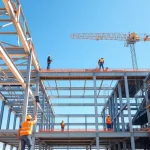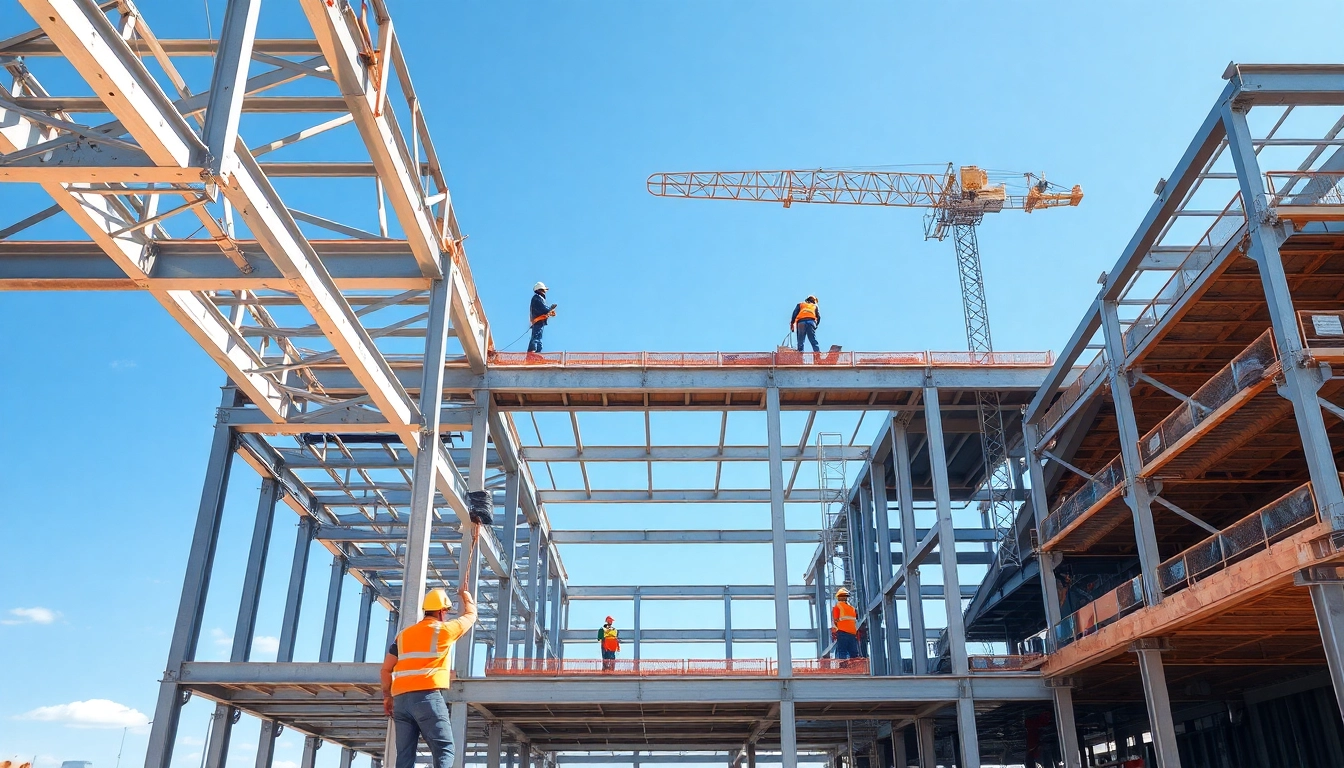Understanding Structural Steel Construction
Structural steel construction forms the backbone of modern architecture and infrastructure, providing strength, stability, and the flexibility needed in various building applications. As a vital material in the construction industry, structural steel allows for the development of complex designs and large structures that are both functional and aesthetically appealing. By exploring structural steel construction in detail, we can understand its importance, benefits, and various applications.
What is Structural Steel?
Structural steel is a category of steel used for making construction materials in a variety of shapes. It’s characterized by its high strength-to-weight ratio, which allows for substantial load-bearing capabilities without excessive material use. This makes it an integral part of the building process, enabling the construction of skyscrapers, bridges, and warehouses.
Common forms of structural steel include beams, columns, and plates, often fabricated to precise specifications during manufacturing. These components are then combined on-site to create support frameworks that can withstand both static and dynamic loads.
Key Properties and Grades of Structural Steel
Understanding the different grades of structural steel is crucial for ensuring that the right material is used for specific applications. Steel is categorized based on its chemical composition, mechanical properties, and British or American standards. Common grades include:
- S235: This grade is typically used in buildings and bridges and has moderate strength and ductility.
- S275: Known for its excellent weldability, this grade is ideal for frame structures.
- S355: This is a high-strength steel primarily used in load-bearing structures, offering superior tensile strength.
In addition to grade, the properties of structural steel such as yield strength, tensile strength, and ductility play pivotal roles in determining their suitability for different projects.
The Role of Structural Steel in Modern Construction
Structural steel’s versatility allows it to play multiple roles within the construction process. Its properties enable architects to design innovative structures that were not feasible with traditional materials. Moreover, its ability to be prefabricated means elements can be manufactured in a controlled environment, reducing waste and improving efficiencies.
Additionally, structural steel is sustainable; it can be recycled without loss of quality which complements modern eco-friendly building practices. This circular economy approach reduces environmental impacts while meeting the demand for new construction projects.
Benefits of Structural Steel Construction
Cost-Effectiveness and Sustainability
Choosing structural steel construction contributes to cost savings and sustainable building practices. Although the initial investment in structural steel may be higher than other materials, its durability, maintenance-free nature, and efficiency translate into lower life-cycle costs. Furthermore, many steel components can be reused or recycled, reducing the environmental impact and making them a sustainable choice for modern construction.
Steel’s longevity and resistance to various environmental factors—such as wind, seismic, and temperature fluctuations—also mean fewer repairs or replacements over time, leading to substantial savings for building owners.
Speed and Efficiency in Building Projects
One of the significant advantages of structural steel is the speed at which projects can be completed. The prefabrication of steel components allows for on-site assembly that significantly reduces construction time. Unlike traditional materials that may require lengthy setting and drying times, steel can be erected quickly, allowing projects to move forward on schedule.
This efficiency is further enhanced through specialized construction techniques, such as modular construction, where entire sections of the building are prefabricated and transported to the site for quick assembly, greatly reducing labor and time costs.
Design Flexibility and Aesthetic Options
Structural steel provides unparalleled design flexibility. The material can be fashioned into a wide array of shapes and sizes, allowing architects and designers to explore and execute their unique visions. Advanced technology in steel fabrication can achieve complex designs that include curves and intricate details that would be challenging with other materials.
Moreover, structural steel can be combined with various other materials like glass and wood, facilitating the creation of modern, attractive buildings that meet both functional and aesthetic needs.
Methods of Structural Steel Construction
Fabrication and Erection Techniques
The fabrication process involves cutting, shaping, welding, and assembling steel components based on engineering specifications. These operations typically occur in a controlled environment, ensuring quality and precision. After fabrication, the steel components are transported to the construction site for erection.
The erection process involves carefully positioning and securing the steel to create a skeleton for the structure. Cranes and other lifting equipment are commonly used in this phase, and safety protocols must be stringently adhered to minimize risks associated with working at heights.
Welding vs. Bolting: What to Choose?
Choosing between welding and bolting as methods of joining steel components largely depends on the application and structural requirements. Welding provides a strong bond and results in a seamless finish, which can be advantageous for aesthetic purposes or when a high-strength connection is needed. However, it requires specialized skills and equipment and may involve lengthy inspection processes.
On the other hand, bolting is simpler and faster, involving the use of pre-manufactured holes and fasteners. It is particularly useful for field connections, as it allows for the parts to be connected quickly, facilitating faster assembly on-site. Each method has its specific advantages, and the choice will often depend on the project requirements, timelines, and safety considerations.
Ensuring Structural Integrity and Safety
Safety is paramount in structural steel construction, necessitating several measures to ensure structural integrity is maintained. Regular inspections during both fabrication and construction phases are essential. Engineers must perform rigorous testing, including stress tests, to confirm that the materials will perform under expected loads.
Furthermore, using quality materials and adhering to regulatory standards guarantees safety. The design process must incorporate factors such as wind loads, seismic activity, and other local environmental conditions to create a robust structure. Engaging experienced professionals and following best practices in engineering and construction will ensure that safety and integrity are prioritized throughout the project.
Applications of Structural Steel in Various Industries
Commercial and Industrial Structures
Structural steel is widely utilized in commercial and industrial structures, from office buildings to manufacturing facilities. Its ability to support large spans makes it ideal for warehouses, where open, column-free spaces are often required for storage and logistics efficiency.
Moreover, the following characteristics make structural steel a preferred choice for these types of applications:
- High strength-to-weight ratio, allowing for more efficient designs.
- Durability, reducing the need for regular repairs and maintenance.
- Speed of construction, enabling businesses to occupy spaces quickly and start operations sooner.
Residential Uses for Structural Steel
While structural steel is commonly used in commercial and industrial applications, it is increasingly being adopted in residential construction as well. Homes constructed with steel frames can achieve greater heights and enhanced design flexibility while minimizing the overall weight of the structure.
Furthermore, steel’s resistance to pests, fire, and harsh weather conditions contributes to longer-lasting, robust homes that require less ongoing maintenance compared to traditional wood framing. Structural steel in residential applications includes support beams, flooring systems, and even finishing touches in architectural design.
Innovations in Structural Steel Technology
Technological advancements have prompted numerous innovations in structural steel construction. Enhanced design software allows for better structural analysis and optimization, which helps engineers create more efficient structures that reduce waste and costs.
Additionally, new coatings and treatments can improve the corrosion resistance of steel, extending its lifespan and reducing maintenance needs. Innovations such as 3D printing are also beginning to play a role, allowing for the creation of custom steel components and joints with unprecedented speed and accuracy.
Future Trends in Structural Steel Construction
Environmental Considerations and Green Building
As the construction industry grows increasingly attuned to environmental sustainability, structural steel is well-positioned to meet these demands. Many steel manufacturers are adopting more sustainable practices, such as reducing energy consumption during production and maximizing the recycling of materials.
Future trends point toward a holistic approach in the construction sector, emphasizing renewable resources and techniques that minimize environmental impacts. Structural steel’s recyclability aligns perfectly with these emerging standards, making it a key component of green building initiatives.
Smart Technologies in Steel Construction
The integration of smart technologies is transforming structural steel construction. Building Information Modeling (BIM) enables precise planning and coordination, enhancing construction workflow efficiency. As projects become more data-intensive, intelligent construction techniques will harness real-time data to optimize design and execution, thus improving safety and reducing costs.
Innovations such as augmented reality and virtual reality will also likely emerge in constructing training and project management, allowing for improved visualization and collaboration among project teams.
Global Trends and Their Local Implications
The construction industry is witnessing global trends that impact local markets. As urbanization accelerates worldwide, regions are experiencing increased demand for infrastructure and housing, directly impacting the steel industry. Advances in shipping and logistics allow for efficient transportation of structural steel, supporting projects in remote locations or developing economies.
Local policies promoting sustainability and renewable practices are further driving innovations within the sector. By staying attuned to global trends, local builders and contractors can leverage structural steel’s advantages to enhance their competitive edge in an evolving marketplace.









